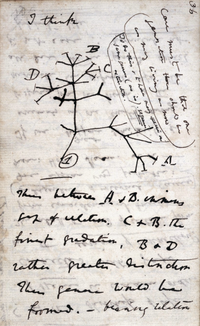
Photo from wikipedia
The relationship between genetic differentiation and phenotypic plasticity can provide information on whether plasticity generally facilitates or hinders adaptation to environmental change. Here, we studied wing shape variation in a… Click to show full abstract
The relationship between genetic differentiation and phenotypic plasticity can provide information on whether plasticity generally facilitates or hinders adaptation to environmental change. Here, we studied wing shape variation in a damselfly (Lestes sponsa) across a latitudinal gradient in Europe that differed in time constraints mediated by photoperiod and temperature. We reared damselflies from northern and southern populations in the laboratory using a reciprocal transplant experiment that simulated time‐constrained (i.e. northern) and unconstrained (southern) photoperiods and temperatures. After emergence, adult wing shape was analysed using geometric morphometrics. Wings from individuals in the northern and southern populations differed significantly in shape when animals were reared in their respective native environment. Comparing wing shape across environments, we found evidence for phenotypic plasticity in wing shape, and this response differed across populations (i.e. G × E interactions). This interaction was driven by a stronger plastic response by individuals from the northern population and differences in the direction of plastic wing shape changes among populations. The alignment between genetic and plastic responses depended on the specific combination of population and rearing environment. For example, there was an alignment between plasticity and genetic differentiation under time‐constrained, but not under non‐time‐constrained conditions for forewings. We thus find mixed support for the hypothesis that environmental plasticity and genetic population differentiation are aligned. Furthermore, although our laboratory treatments mimicked the natural climatic conditions at northern and southern latitudes, the effects of population differences on wing shape were two to four times stronger than plastic effects. We discuss our results in terms of time constraints and the possibility that natural and sexual selection is acting differently on fore‐ and hindwings.
Journal Title: Journal of Evolutionary Biology
Year Published: 2022
Link to full text (if available)
Share on Social Media: Sign Up to like & get
recommendations!